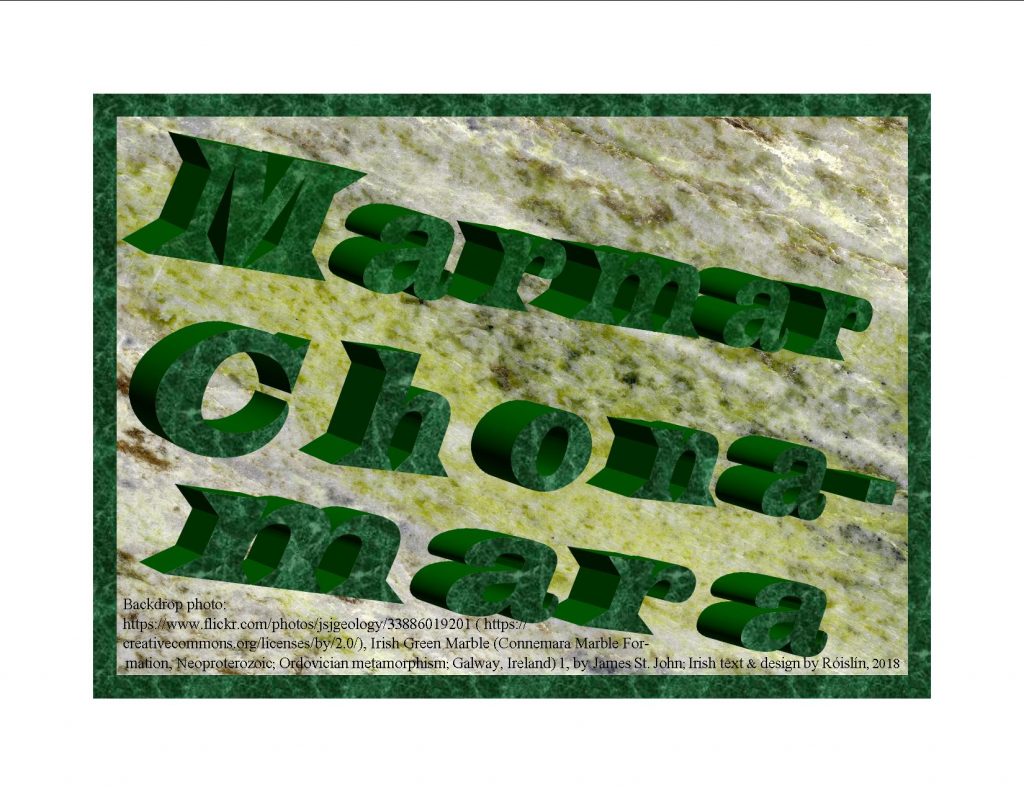Irish Green Marble aka Connemara Marble (Marmar Chonamara, i nGaeilge) Posted by róislín on Aug 10, 2018 in Irish Language
(le Róislín)
Somewhat randomly, I picked a style called “Green Marble” for the lettering in the graphic for the most recent blog (nasc thíos). I liked the color green (always evocative of Ireland) and the bold diagonal layout that came with this pattern in WordArt. But it got me thinking, sure looks a lot like Connemara marble, doesn’t it? So I figured that would be a good topic for “an chéad bhlagmhír eile” (the next blogpost).
It’s a fairly straightforward phrase really, marmar Chonamara. There are only three main things to remember:
- Word order: “Conamara,” as the modifier, comes second. It’s not technically an adjective, but we’re using it as one, as we do with the second noun in phrases like “scian phóca” (a pocket knife) or “hataí fear” (men’s hats).
- Inserting the “h” after the “C” of “Conamara” — This is to show that the marble is “of Connemara.” Irish doesn’t use a word for “of” in phrases like this but adds “h” to the second noun to show possession, or at least a relationship like possession (an tuiseal ginideach). If you’ve been doing Irish for at least a little while, you’ve probably already encountered phrases like “cóta Cháit” (the coat of Cáit) and “muintir Bhostúin” (the residents of Boston), which also show this “h-insertion,” technically known as “séimhiú” or, in English, “lenition.”
- Pronunciation: when we change “Con-“ to “Chon-,” the pronunciation changes. “Conamara,” as most of you probably know, starts with an initial “K” sound. But this “ch” is like the “ch” in German “Buch” or Yiddish “Chutzpah” or in Irish words like “ach” or “gach.” Rough transcription guides usually show this as “kh,” so we could say “khon-uh-MAH-ruh.”
Among the most popular things to be made of Connemara marble are “seodra” (jewelry), “paidríní” (rosary beads), “cláracha gearrtha” (cutting boards), “cláracha cáise” (cheeseboards), “cóstaeir” (coasters), “lúibíní cufa” (cufflinks), and “earraí cuimhneacháin ó Éirinn” (souvenir items from Ireland). An bhfuil aon rud agat atá déanta as marmar Chonamara? Do you have anything that is made from Connemara marble? If so, perhaps you could write in and tell us about it – what it is and why you like it, más mian leat. Ar cheannaigh tú in Éirinn é nó ar line? Did you buy it in Ireland or online? Ar thug tú cuairt ar an gcairéal ina ndearnadh é? Did you visit the quarry in which it was made? Bheadh eolas ar bith suimiúil. Any information would be interesting and good practice for others to read.
Here are some more phrases to practice the word “marble,” not necessarily the Connemara type.
dealbh mharmair, a marble statue, pl. dealbha marmair, marble statues, sometimes simply called “marbles”. But these aren’t the kind you “lose,” for which please see below.
For the Elgin Marbles, we can say, “Marmair Iarla Eilginn,” lit. the marbles of the Earl of Elgin. Not that they were really his, ach sin scéal eile ar fad. The more accurate name would be “Marmair an Phartanóin.”
tinteán marmair, a marble fireplace
bonn marmair, a marble base, as for a statue or trophy
And just for fun, we could practice these phrases:
mar mharmar Chonamara, like Connemara marble
martán déanta as marmar Chonamara, a small ox made of Connemara marble, speaking of dealbha (statues) or deilbhíní (statuettes, figurines), ar ndóigh
So, as you’ve just seen above, for things that are literally made of marble, we use either “mharmair” or “marmair” (both meaning “of marble”). But for something that is actually “marbled,” like cake or the marbled white, a type of butterfly, we can use an actual adjective form, “marmarach,” as in “an císte marmarach” or “an bhánóg mharmarach.”
If something has been “marbled,” like paper or cheese, we can use “marmaraithe,” from the verb “marmaraigh.” So we have “ciumhais mharmaraithe an leabhair” or “imeall marmaraithe an leabhair” (the marbled edge of the book) and “cáis mharmaraithe” (marbled cheese, e.g. gormán, blue cheese). But if it’s meat, mairteoil mar shampla, we don’t use any form of “marmar;” instead we say it has “geir” (fat) throughout it (tríd/tríthi).
Finally, while “marbles” for playing the game are “mirlíní,” you might find it fun to learn an Irish expression for “She’s lost her marbles.” — “Tá sí as a meabhair” (lit. “She is out of her mind”). Most idioms don’t translate from language to language, so the Irish expression has nothing to do with mirlíní or marmar. Hope you found this interesting and that you’ll check out some Connemara marble goods. – SGF — Róislín
And btw, here are some links to Connemara marble websites:
https://www.theirishstore.com/celtic-jewelry/connemara-marble
https://www.connemaramarble.com/product-category/marble-gifts/
https://www.myirishjeweler.com/blog/what-is-connemara-marble
http://irishgreenmarble.com/?p=123
and some reviews of the Connemara Marble Visitors’ Center in Moycullen, Co. Galway: https://www.tripadvisor.com/ShowUserReviews-g1386579-d3993353-r539808818-Connemara_Marble_Visitor_s_Center-Moycullen_County_Galway_Western_Ireland.html
nasc don iarbhlag faoin litir ‘Z’: Some Irish Words Beginning with the Letter ‘Z’ (zaip go zú) Posted by róislín on Aug 7, 2018 in Irish Language

Build vocabulary, practice pronunciation, and more with Transparent Language Online. Available anytime, anywhere, on any device.





Leave a comment: